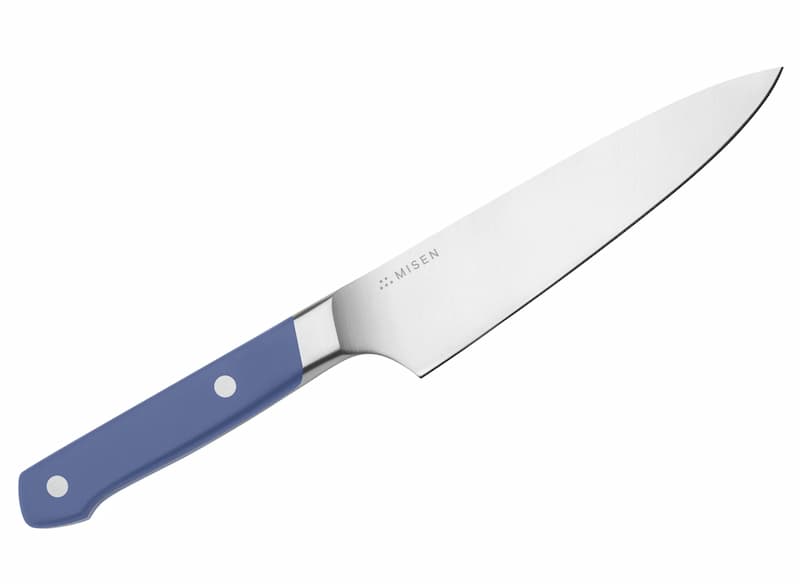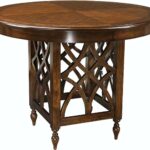In this in-depth review of the Misen 8-Inch chef’s knife, you’ll learn:
Although Wusthof and Shun’s higher-end chef knives are mentioned in Misen’s marketing materials, we did not find that the Misen chef knife could compete with them in terms of pure performance.
From a performance perspective, it was not even close to the best chef knives under $100. However, it provides a reasonable balance between toughness and performance, making it a good choice if it will serve as your sole chef knife. A great feature for people who detest sharpening knives is Misen’s lifetime free sharpening policy.
Specifications
| Overall Length: | 13.5″ |
| Blade Length: | 8″ |
| Style: | Gyuto Chef |
| Handle Length: | 5.25″ |
| Handle Material | TPE |
| Blade Steel: | AUS-10 |
| Blade Grind: | Flat |
| Blade Angle: | 15 ° |
| HRC Rating: | 58 |
| Weight: | 8.9 oz |
Pros
| Tough |
| Good fit and finish |
| Good steel with decent heat treatment |
| Lifetime warranty |
| Unique look |
| Lifetime free sharpening |
| Full tang |
Cons
| A little too thick behind the edge |
| Sub par at dicing |
| Stamped as opposed to forged, blade. |
The Design
The blade of the Misen knife is curved in the conventional Western style, but it also has a thin profile and a light weight similar to those of a thinner, Japanese-style blade, making it a hybrid style of knife. The blade’s curve varies between that of a strongly curved German knife and a more subtly sloped French knife. This is exactly how I want it. Excellent for rock-chopping herbs, straight and nimble enough for fine tasks like deboning a chicken or slicing an onion, and sturdy enough for larger tasks like splitting squash or potatoes.
You’ll notice the knife has a forged bolster—that is, an enlarged area where the knife blade meets the handle—as you move down the blade toward the handle. In addition to improving the knife’s balance and control, this also improves the comfort of holding the blade. With its smooth steel lines and a backward slope, the bolster invites you to use the “pinch” grip, where the blade is held between your forefinger and your thumb. Professional chefs use this grip because it offers better control than the handle grip favored by many less expensive knives.
It is also more comfortable due to its curves. Some metal-bolstered knives, like my Global G-2, are too thin, eventually digging into your hand and, in my case, leaving you with an uncomfortable callus. The Misen feels like it was designed to be a natural extension of my arm, just like a good knife should. With plenty of space for your hands, you can slice effectively without banging your knuckles on the board.
Speaking of extensions, the blade of the knife extends all the way to the butt of the handle (this section is called the “tang”). A full tang is essential for longevity as well as balance (this knife will balance evenly on your hand like a see-saw if you place one finger underneath the bolster). This knife will last significantly longer than cheaper knives with their partially embedded tangs because it has a full tang and dual rivets that secure the handle to the blade. Have you ever stumbled upon a knife at an antiques fair that lacked a full tang? They simply don’t last, and that explains why.
The Materials
The handle’s peculiar appearance is probably the first thing you’ll notice. It’s made of a dense plastic composite and is available in a variety of colors (the black version is a stretch goal that won’t be made available unless they reach that target during the Kickstarter campaign). It is heavy, grippy, and dense. No complaints there.
Knife steel is a persistently divisive topic. How fervently do you want it? What is the ideal carbon level? How can you best balance affordability with both durability and sharpening simplicity? The AUS-8 Stainless steel used to make the Misen knife is a Japanese alloy with a.75% carbon content and vanadium to increase its durability. Similar to a Japanese knife, this blade is sharpened at a very steep angle of 15 degrees, giving you a razor-sharp edge.
Apart from its stainless qualities, AUS-8’s main benefit is that it’s very simple to sharpen and polish into a razor edge. Right out of the box, this device was easily splitting tomatoes and slicing onions into translucent ribbons. The blade could have used a little more honing, but it was already sharp enough to cut a tomato in half by simply dropping it on the edge and letting gravity do the work.
The disadvantage is that it will wear out a little bit more quickly than a knife made of a harder alloy because it is a softer steel. In other words, you’ll need to take good care of your knife; you shouldn’t put it in the dishwasher or store it without a cover. You should also have it professionally sharpened a few times a year as the sharpness starts to wear off.

The Price
$65. That is a fantastic offer. Yes, there are less expensive knives available, such as the Forschner Victorinox Fibrox knives that Cook’s Illustrated frequently promotes, but when you hold these two knives side by side, the Forschner feels like a baby’s toy due to its stamped blade, plastic handle, poor balance, and lack of solid riveting. I’ve held a lot of knives over the years in all price ranges, but none have ever offered the kind of value that this one does.
To the folks that say, “Well I’ll get that $35 knife—it’s so cheap that we can replace it if it breaks,” I’d say that for less than twice that amount, you can get a knife that won’t break, will feel better in your hand, will cut better, is easier to sharpen, has superior control, and will teach you better cooking habits (like the pinch grip) in the process.
Whatever way you cut it, that math is fairly simple.
What Others Are Saying
Investors have supported this brand from the start, as shown by the Misen 8-Inch Chef’s Knife’s phenomenal success and its $1 million+ Kickstarter campaign. This upfront financial commitment is a reflection of brand faith. Furthermore, Misen has high ratings and praise from thousands of verified buyers on its site.
Top consumer product review websites like Good Housekeeping and CNET will also list Misen as a contender. Here is a shortlist of the brand’s recent accolades:
- The Misen 8-Inch Multi-Purpose Chef’s Knife was named by Good Housekeeping as the best in its category. They praised it highly for its clarity, robustness, balance, and comfort.
- The Misen knife offerings were named the Best Looking Direct-to-Consumer Kitchen Knives of 2020 by CNET. The reviewers praised the knife’s affordability as a major advantage, but they also praised its robustness, comfort, good looks, and overall feel.
- The Misen 8-Inch Chef’s Knife was named the Best Heavy Chef’s Knife by Epicurious after being put through a series of tests. The value, design, and comfort received positive feedback from testers.
- The Best No-Fuss, Direct-to-Consumer Chef’s Knife, according to the Strategist, is the Misen 8-Inch Chef’s Knife. Its weight, sharpness, and comfort were praised.
Users and product reviewers of Misen are obviously pleased with this knife. It is simple to test it out and determine if it is the right knife for you with a 60-day home trial period.
So…Should You Buy It?
Yes, even though the knife doesn’t live up to the same high standards as the best chef’s knives, it is still a fantastic purchase. At a much lower price, it provides excellent looks, feels, and performance.
If you want a quality knife that won’t break the bank, buy the Misen 8-Inch Chef’s Knife. Additionally, you can try it out risk-free thanks to their kind 60-day return policy.
If any of the cons are deal-breakers for you and you have a little extra to spend, the Made In 8-inch chef’s knife is a good alternative. It has a wider blade and a rounder handle, is made in France with verified production standards, and even though it costs more, it’s still a great deal.













